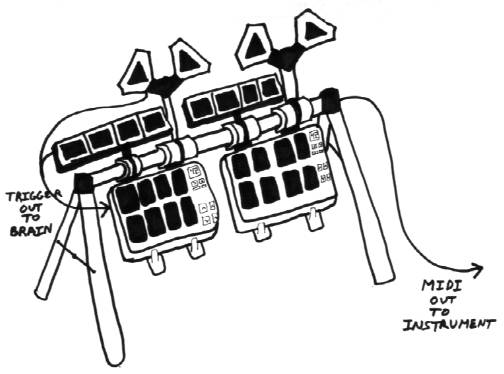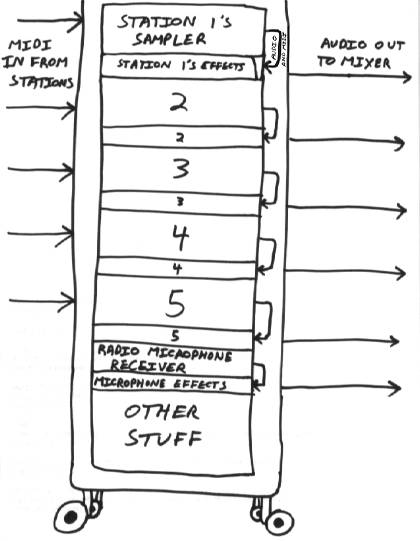The new InSoc98 live show stage consists of five stations, one player per station, arranged like this:
The exact arrangement must sometimes be changed to accomodate small or oddly-shaped stages.
The new show has NO BACKING TRACKS. NO TAPE. NO DAT. NO SEQUENCERS. We are playing
ALL LIVE. The only use of tapes is pre and post-show music and
intro sounds. (And I'm not so sure we'll even bother with that.) We may use a sequencer program running on a computer
as a metronome for the drummer, but a plain metronome might be just as good.
 |
To the left is a diagram of a stage station. Each station consists of a drum hardware stand with 14 - 28
percussion pads. The black surfaces represent these pads which we hit with
drumsticks. The pads send MIDI note numbers to a digital sampler off in a rack
on the side of the stage. These instruments contain stored sounds which have been set up to play back at a certain
pitch, in a certain way for each note number. When the sampler receives the note number, it plays the sound or sounds
associated with that note. This sound is fed to the main mixing board where it is blended with the sounds coming from
the other four stations and the microphones.
The station in this diagram has 2 Roland Octapads, 2 4-pad supplimentary pad racks, and 4 supplimentary
triangle pads. These supplimentary pads send a trigger to the Octapads, which
send out MIDI dat in response just as if it were one of the built-in pads.
Some stations also have a small keyboard controller for parts which don't play well on pads,
such as keyboardy-synthy solos.
|
|
To the right is a diagram of the primary equipment rack. Each station sends MIDI data to its sampler or
other instruments. The sampler also passes this MIDI data along to an effects (reverb, delay, etc.) unit, to change
from one sort of effect to another. The audio from the sampler goes into the effects unit. The audio then goes out
to the house mixer. The microphone sends out radio light*
to the receiver, which translates the radio signal back into electricity. This audio signal
is then sent to its effects unit, and then out to the mixer, also.
At the mixer, an audio engineer who travels with us, or sometimes an employee of the venue, listens to it
all and makes judgements about how loud various things should be, and whether
equalization is required.
|
 |
HERE is a complete list of the equipment we're using on the road.
*Radio waves are just a form of light our eyes can't see. Unlike visible light,
radio-frequency light can go through walls and stuff.

